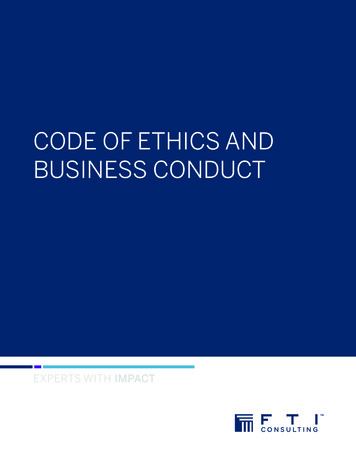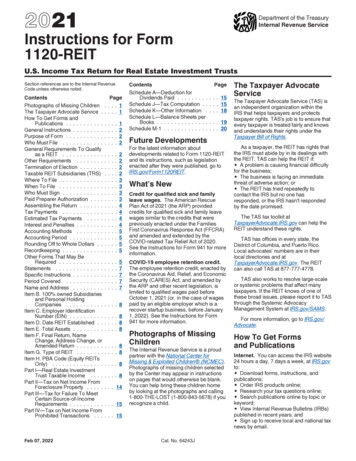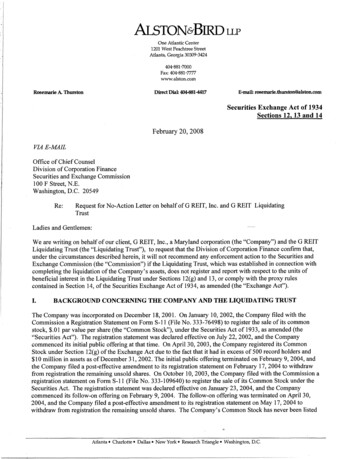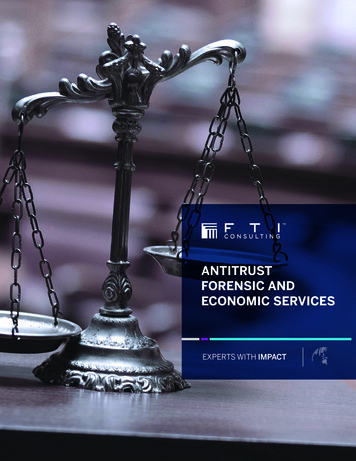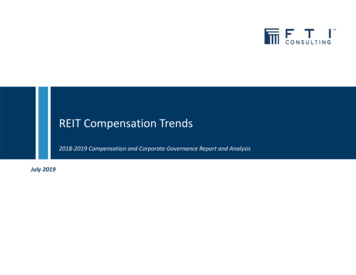
Transcription
REIT Compensation Trends2018‐2019 Compensation and Corporate Governance Report and AnalysisJuly 2019
AgendaSectionPage Firm Introduction3 Executive Summary – Key Findings6 2018 Compensation Adjustments9 Executive Compensation Design Trends14 2019 Say‐on‐Pay Results24 Board Compensation Trends29 Additional Trends and Current Issues in Executive Compensation and Corporate Governance362
Firm Introduction3
Today’s PresentersLarry Portal is a Senior Managing Director at FTI Consulting and is based in Roseland, New Jersey. Mr.Portal is a member of the Corporate Finance group where he co‐leads the firm’s ExecutiveCompensation and Corporate Governance practice, leads the firm’s Business Tax Advisory group and isinvolved with several firm initiativesLarry PortalSenior Managing DirectorMr. Portal has achieved industry‐wide recognition for his tax expertise in the structuring of corporateand private real estate transactions, including mergers and acquisitions. In addition, he is widelyconsidered a leading expert in the field of REIT and real estate executive compensation and hasconsulted with many leading public and private real estate companies in the design and implementationof their compensation programsRoseland, NJ 1 973 852 8147Larry.Portal@fticonsulting.comKatie Gaynor is a Managing Director at FTI Consulting and is based in Charlotte, North Carolina. Ms.Gaynor is a member of the Corporate Finance group and co‐leads the firm’s Executive Compensationand Corporate Governance practiceKatie GaynorManaging DirectorCharlotte, NC 1 704 972 4145Katie.Gaynor@fticonsulting.comMs. Gaynor has over 15 years of executive and corporate governance consulting experience. During thistime, her responsibilities have included compensation planning and structuring for public and privatecompanies, drafting compensation disclosures to comply with requirements set forth by the Securitiesand Exchange Commission (SEC), conducting corporate governance reviews, compensation planning forinitial public offerings and for mergers and acquisitions and developing industry‐related compensationsurveys. Ms. Gaynor has also worked on several REIT transactions, including IPO structuring andInternalizations, deal negotiations, earn‐out structuring and the preparation of shareholdercommunications4
Executive Compensation Practice at FTI ConsultingThe Executive Compensation and Corporate Governance Advisory Practice at FTI Consulting has served as the trusted advisor toover 100 public and private real estate companies, providing the following services:Competitive Compensation ReviewIncentive Plan DesignProxy‐Related ServicesCorporate Governance ServicesPeer group development andbenchmarkingPerformance metric and goal setting todrive real performanceDraft proxy content and designgraphicsShareholder engagement and outreachPay magnitude and program structurePay mixCalculate potential severancepaymentsGuidance on institutional investor andproxy advisor policiesEmployment and severanceagreementsPlan leverage and calibrationCEO pay ratio calculationsBoard and executive evaluationsSalary banding and gradingAccounting and tax implicationsEquity incentive plan designSuccession planningPay philosophy and objectivesPlan vehicle selectionAudit of compensation tablesCompensation risk assessmentsBoard of directors compensationPayout calculationsForecast pay‐for‐performance resultsunder the ISS modelCorporate governance diagnostics5
Executive Summary – Key Findings6
2018 Compensation Trends – Key Takeaways6%Overall increase in 2018 executive pay levels over 2017,with actual increases ranging from 0% to 7% by position30%Median Pay Increase(All Positions)30%MSCI US REITIndex TSR25%20%Compensation adjustments varied across the different REIT sectorswith Diversified REIT CEOs receiving the highest median increaseof 20% (due in part to special equity grants at these companies)15%10%5%CEO cash bonuses increased by 8.5% in 2018 compared to almost3% in 2017. The median payout as a percent of target was121% of target in 2018 versus 123% in 2017Outsized equity awards (including supplemental one‐time awards)continues to be a pressure point, with ISS citing this as an area ofconcern at 63% of self‐managed REITs that received an Againstvoting recommendation477:1The highest REIT CEO pay ratio; median ratio of 0180%‐5%‐5%Fewer self‐managed REITs failed Say‐on‐Pay in 2019 despiteincreased pressure from ISS2 REITSFailed Say‐on‐Pay (down from 3 in 2018) while ISSissued an Against voting recommendation for 19 self‐managed REITs (up from 15 in 2018)Non‐TSR performance metrics are increasing in prevalence, withIndustrial, Office and Mortgage REITs significantly increasing utilization7
Recent REIT Market TrendsRevisiting Performance Share Plan Design. Following the adoption of Say‐on‐Pay, the use of performance‐basedequity soared with most REITs using relative TSR as the primary performance metric (77% of REITs use relative TSR). ManyREITs are conducting more extensive reviews of the performance share plans and making adjustments as appropriate Increased use of non‐TSR measures (metric diversification) Focus on understanding the accounting impact and how to manage the cost of these programs Reviewing results of past plans to ensure that the relationship between pay and performance were appropriatelycorrelatedFocus on Setting Cash Bonus Goals. Short‐term incentives should be based on performance targets that areconsidered achievable, but require strong effort, which requires rigorous planning and forecasting. The onus for REITs withdeclining profitability is even higher “Maximum” payouts may need to include more significant stretch goals than prior plans since it is harder to justify abovetarget payouts in periods of declining profitability and should require extraordinary effort ISS guidelines state that “clear disclosed rationale for lowered financial performance targets” is necessary If the decline is a direct result of mismanagement, paying significant value to executives to “fix their mistakes” may beharder to justifyImpact of M&A on Compensation. M&A activity continues to rise and has resulted in: Implementation of new employment agreements, severance arrangements and Change‐in‐Control provisions incompensation programs (for both the C‐Suite and the broader employee population) Description of the program in termsof both dollar values and structure in a more tabular/bulleted format Proactively reviewing potential 280G tax implications8
2018 Compensation Adjustments9
Compensation Trends by PositionMedian compensation levels in the REIT industry increased (decreased) from 2017 to 2018 by position as follows(1):PositionAll Incumbents (576 Incumbents)Base Salary2.9%Cash Bonus5.5%LTI GDFV3.9%Total Comp6.0%Chairperson (19 Incumbents)0.0%2.3%0.0%0.0%Chief Executive Officer (146 Incumbents)0.0%8.5%4.5%6.9%Chief Operating Officer (65 Incumbents)3.0%2.6%6.6%7.0%Chief Financial Officer (124 Incumbents)3.0%5.3%3.8%6.6%Chief Investment Officer (37 Incumbents)2.9%2.6%‐1.6%4.0%General Counsel (66 Incumbents)3.0%6.2%5.5%5.9%Other Executives (119 Incumbents)3.1%6.0%5.3%5.8%Chairperson compensation continues to experienceincreased scrutiny; of the 19 incumbents, 9 had areduction in compensation, with a median decreaseof 16%“Reportable” pay is more correlatedto annual earnings and operationalperformance and less on 1YR TSRperformance, which resulted in payincreases despite negative 2018returns in the REIT industryFootnotes:(1) Only includes incumbents who served in the same role in both 2017 and 2018. New hires and promotions were excluded from theanalysis10
Distribution of 2018 Changes in CompensationCompensationincreased formost REITexecutives acrossall positions buta meaningfulpercentage alsoreceived payreductions in20183%Chief Executive Officer (146 Incumbents)33%Chairperson (19 Incumbents)64%47%11%42%3%All Incumbents (576 80%100%11
Compensation Trends by REIT Sector (CEO & COO)LegendOne‐Year REITSector TSR75th PercentileChief Executive �10%25th Percentile‐20%Diversifiedn 13One‐Year REITSector TSR data is asof 12/31/2018based on theapplicable SNLsector indexHealthcaren 13Hotel & Resortn 16Industrialn 10Mortgagen 10Officen 18Residentialn 16Retailn 26Specializedn 24Chief Operating Officer30%20%12%10%0%6%ISD5%ISDISDDiversifiedn 6HealthcareHotel & Resortn 9IndustrialMortgage8%4%2%‐10%‐20%Officen 12Residentialn 9Retailn 16Specializedn 512
Compensation Trends by REIT Sector (CFO & Other Executives)LegendOne‐Year REITSector TSR75th PercentileChief Financial Officer30%20%10%Median13%10%6%0%11%5%2%Industrialn 8Mortgagen 8Officen 1711%5%‐1%‐10%25th Percentile‐20%Diversifiedn 9One‐Year REITSector TSR data is asof 12/31/2018based on theapplicable SNLsector indexHealthcaren 11Hotel & Resortn 12Residentialn 14Retailn 22Specializedn 23Other Executives(i ncl udes Chief Investment Officer, General Counsel a nd Other excluding Chair)30%20%10%11%0%8%‐1%3%Healthcaren 18Hotel & Resortn 2211%6%9%3%6%‐10%‐20%Diversifiedn 17Industrialn 17Mortgagen 21Officen 30Residentialn 24Retailn 33Specializedn 4013
Executive Compensation Design Trends14
2018 Pay MixThe pay mixbetween the fourkey componentsof executivecompensationhas remainedrelativelyconsistent overthe past fewyears3%3%19%54%49%CEO23%COO24%3%25%SalaryCash BonusLTIOther3%44%48%24%CFO26%OtherExecs26%27%15
Annual Cash Incentive Plan DesignPlan Design – Formulaic cash incentive plans that incorporate a discretionary component continue to be the most commonlyutilized plan design (based on the design used for the CEO)–80% allocation to objective, corporate measures and 20% to discretionary or subjective measures remains the mostfrequently utilized allocationBonus Plan StructurePlan Type*Entirely DiscretionaryEntirely FormulaicFormulaic with a Subjective 1613%25%62%201722%20%58%201823%17%60%*Includes bonus pools, sorted into category most closely aligned with the programThe use of 100% formulaic plans continues to decrease as REIT boards look tobalance quantitative metrics with other operational and strategic prioritiesthat may not be quantifiableBonus Targets – Target bonus opportunities (as a percentage of base salary) has remained relatively consistentPositionChief Executive OfficerChief Operating OfficerChief Financial OfficerChief Investment OfficerGeneral CounselOther ExecutivesTarget Annual IncentiveDollar Value% of Salary 860100%390,035100%Leverage as % of %150%25%126%16
Cash Bonus Payouts2018 CEO cash bonus payouts were 21% above target (at the median), with approximately 72% of CEOs receivingpayouts above targetCash bonus payouts increased by 8.5% year‐over‐year while payouts as a percent of target decreased from 123% to 121% oftarget indicating that CEO bonus opportunities increased in 20188 REIT CEOs in 2018 received a bonus payout at the Maximum Level2018 CEO Bonus Payouts Compared to TargetBelow Target22%At Target 6%Above Target72%17
Annual Cash Incentive Plan Design – MetricsBased on the CEO’s annual cash incentive plan, most REITs used between 3 and 5 bonus metrics as companies aim to balancemotivating excessive risk‐taking by using too few metrics and focusing management on critical business objectives–The utilization of 3 metrics was the most prevalent (up from 18% in 2017); historically 4 metrics was the most common–The number of REITs using 6 metrics increased (21% of REITs in 2018 vs. 16% in 2017) after years of steady decline; REITsgoing through “disruptive” periods are including additional strategic priorities while continuing to use earnings andoperational metrics30%25%25%% of REITs20%24%15%15%12%10%10%11%67 5%4%0%12345Number of Metrics18
Annual Cash Incentive Plan Design – Most Prevalent MetricsThe most commonly utilized corporate performance metrics continue to be per share earnings metrics, with the followingrepresenting the most common corporate metrics (in order of prevalence):–Using an FFO‐based metric is the most common (either NAREIT‐defined, Core, Normalized or Adjusted) and is used by 81%of REITs–Same‐store NOI and Leverage Ratios continue to be the most utilized non‐earnings metrics in the REIT industry–Operating expenses increased in use (less than 10% last year) and appears on the most prevalent list for the first timeMost Prevalent Performance MetricsSame‐Store NOI33%Core or Normalized FFO32%Leverage Ratios28%Adjusted FFO27%EBITDA/Net Income23%FFO22%Operating Expenses11%Occupancy11%Acquisitions11%19
Equity Compensation Vehicles100%The majority of REITs utilized2 equity compensation vehiclesPerformance shares continue to use forward‐looking performance goals50%70%Approximately 25% of REITs utilize LTIP Units as aform of equity25%25%5%0%123 years continues to be the most prevalent vesting3and performance periodNumber of Equity Vehicles100%2018201775%% of REITs% of ed SharesBackward‐LookingPerformance SharesForward‐LookingPerformance SharesType of Equity VehicleStock Options/SARs20
Performance Share ModifiersMore REITs have begun using a performance share modifier that acts as a secondary measurement31%of REITs that useperformance shares use amodifier (up from 26% in2017)Modifiers can limit, multiply, reduce or set minimum payout levelsafter the primary or initial payout calculation75% of REITs that use a modifier use absolute TSR as the secondary measurement,Absolute TSRfollowed by relative TSR as the second most commonly used metricis the most commonly used modifierOnly one REIT uses a non‐TSR modifier based on Net Debt/EBITDA and three REITshave a discretionary modifier based on the Compensation Committee’s assessmentof absolute TSR and other qualitative assessments53%of modifiers limit the payout Multipliers are the next most common modifier (representing 33%) and adjust theaward up or down, with a plus or minus 50% adjustment being the mostif absolute TSR does notprevalent (vs. 25% adjustment in 2017)meet a certain thresholdModifiers continue to increase inutilization in response to ISS criticism4 REITs (or 21% of REITs with a negative ISS say‐on‐payvoting recommendation) were criticized for not limiting orcapping payouts if absolute TSR is negative21
Performance Share Metrics77% of REITs that grant performance shares use relative TSR as a metric(represents the most widely used performance share metric)The use of sector‐based comparison groups continues to the most widely usedNon‐TSR metrics are increasing in prevalence, with approximately 43% of REITs using at least onefinancial/operational metric in their LTI program (up from 37% in the 2017)Increase in non‐TSR measure utilization during 2018 was largely driven by the select REIT sectors:Increase in Utilization of Non‐TSR Metricsby REIT Sector 28%42%14%Industrial 12%45% 9%30%33%21%Mortgage2019Office201822
Innovation in Long‐Term IncentivesOutperformance Time‐Based Shares “Original” time‐based equity award will vest solely basedon time and will not be subject to risk of forfeitureassociated with performance‐based conditions “Outperformance” modifier can increase (but notdecrease) the original time‐based award by up to 2x‐3xfor achievement of certain operational/earnings goals This concept is in addition to more traditionalperformance‐based equity grants“AO” LTIP Units Represents a stock appreciation right in the REIT’sOperating Partnership with pre‐tax economic benefitssimilar to stock options Generally provides for capital gains tax treatment REITs have included performance hurdles (in addition tothe necessary stock appreciation required to be in “in‐the‐money”)Promote‐Based Programs Allows management/investment professionals to earna portion of any promote income received by the REIT(usually in connection with a fund business, but mayalso be a JV) Competitive compensation element, particularly forthose competing with private equity firms for talent Can be structured as profit interests for capital gainstax treatment purposesEmployee Stock Ownership Plan Most commonly used to provide a market for ownersof successful closely held companies to motivate andreward employees, or to take advantage of incentivesto borrow money for acquiring new assets in pretaxdollars ESOPs have a number of potential tax benefits While usually not used at public companies, one REITuses an ESOP in lieu of equity compensation23
2019 Say‐on‐Pay Results24
2019 Say‐on‐Pay ResultsDespite receiving more Against recommendations from ISS in 2019, REITs fared better in terms of failed Say‐on‐Pay proposalsIndustry/IndexAll REITsSelf‐Managed REITsExternally‐Managed REITS(EMIs)Russell 8%ISS Against .9%1139.3%1145.8%28813.3%28613.7%Failed .0%14.2%502.3%472.3%Source: ISS Corporate Solutions for data available as of July 2, 2019The guarantee of 90% shareholder support with a positive ISS recommendation is fading as investors and shareholders aremore apt to formulate their own opinions on executive pay matters‒Over the past couple of proxy seasons, most large institutional shareholders have conducted due diligence in conjunctionwith their own independent policy positions, even if the proxy advisory firms recommended “For” a Say‐on‐Pay proposal–CalPERS voted “Against” 43% of Say‐on‐Pay proposals for US companies in the Russell 3000 during 2018 (vs. ISSrecommended “Against” 14% of companies); largely driven by CalPERS policy for 5 year vesting/restriction period to beconsidered “long‐term”(1)Total number of Say‐on‐Pay proposals each year may vary based on reporting companies; accordingly, the percentage listed may not coincidewith the increase (decrease) in the number of companies year‐over‐year25
Snapshot of Self‐Managed REIT Say‐on‐Pay Results19 self‐managed REITs received a negative Say‐on‐Payvoting recommendation from ISS in 2019, up from 15 in2018Average Support at All REITs94%93.0%92%93.3%91.9%2 REITs failed Say‐on‐Pay91.0%90.7%REITs that received 80% ‐ 85% shareholder supportfollowing a positive ISS recommendation increased to 4indicating the downward pressure experienced whendeviating from policies of a particular institutional investor90%88%2015100%2016201720182019Average Support at REITs based on ISS Number of REITs with an ISS Against VotingRecommendation vs. Failed Say‐on‐Pay or2017Against2018201920142015Received Against Recommendation20182019Failed Say‐on‐Pay26
Factors Influencing ISS Voting RecommendationsA perceived pay‐for‐performance misalignment continues to be the main precursor of negative votingrecommendations–89% of self‐managed REITs that received an Against were cited for pay‐for‐performance misalignment–2 REITs with a “Low” concern triggered negative recommendations based on severance provisionsFactors outside of a pay‐for‐performance disconnect cited by ISS included:63%21%had outsized equity awards, either annual grants orsupplemental one‐time awards, often despitesustained TSR underperformanceprovided significant perks – automobile‐related orlarge enhanced life insurance perks26%58%had outsized STI targets and/or outsized base salaryamounts (or significant increases without compellingrationale)had problematic STI (Cash Bonus) program designfeatures, including largely discretionary plans or lackof pre‐set financial metrics68%53%were cited for the rigor of their performance goals(STI or LTI), including rTSR targets at or below medianand uncapped payouts for negative absolute TSRhad problematic LTI (Equity) program design features,including annual performance periods, insufficientperformance‐based awards or retesting features58%had problematic severance‐related provisions, including excise tax gross‐ups, excessive severance basis and single‐triggerequity vesting* All percentages are out of 19 that received an Against Say‐on‐Pay voting recommendation from ISS27
Spotlight on Equity Plan ProposalsDuring the 2019 proxy season, ISS recommended Against equity plan proposals to increase the number of sharesreserved for compensation purposes despite receiving a passing score under the modelThe foundation of ISS’ equity plan review is based on the points earned under the Equity Plan Scorecard that evaluates plancost, grant practices and plan featuresIn select circumstances, ISS has now begun issuing an adverse voting recommendation on equity plan proposals even insituations when a company is above the 53 point threshold necessary under the Scorecard if:–A pay‐for‐performance misalignment is identified in connection with the Say‐on‐Pay proposal; AND–Equity utilization is not considered “broad‐based” and is heavily concentrated to grants made to the CEO and otherNEOs (i.e., 3‐year average concentration ratio of grants greater than 30% for the CEO or 60% for all NEOs, inclusive of theCEO)While ISS issued 8 negative voting equity plan recommendations, no REIT failed to approve an equity plan proposal with thelowest support at 73.5%28
Board Compensation Trends29
REIT Board Compensation Trends2018/2019 board compensation levels were relatively unchanged at the median(by comparison, average board compensation increased by 5%)39%of REITs increased boardcompensation (same as 2017)The pay mix continues to be biased in favor of equity over cash (slight shift up from60% in 2017/2018)39/61 pay mixCash / Equity (at the median)24%At REITs that increased board compensation, the median increase was 10% (downfrom 13% in 2017/2018)Equity is almost always delivered in full‐value shares awarded under a fixed‐dollarvalue formula with immediate and one year being the most common vesting periodsof REITs pay meeting fees(down from 26%)8board members43% of REITs that pay meeting fees only pay fees above a certain threshold toprovide additional compensation in years that the board is more active (mostcommonly 8 meetings)At the median, most boards have 7 non‐employee directors that are paidcompensation for their board service30
Additional Retainers and FeesMost REITs provide additional fees for service as non‐executive chair/lead independent director andcommittee chairpersons in recognition of their additional time commitments and responsibilitiesThe number of REITs that pay committee member fees increased slightly from 2017 to 2018Committee member fees are generally equal to 50% of the chairperson feeGovernance committee fees increased modestly in conjunction with enhanced responsibilities2018Fee/RetainerLead Independent DirectorNon‐Executive ChairCommittee Meeting FeesCommittee ChairAuditCompensationNominating & GovernanceCommittee MemberAuditCompensationNominating & Governance2017Prevalence48%43%22%Median Pay 25,000 75,000 1,500Prevalence51%39%27%Median Pay 25,000 75,000 1,50094%91%86% 20,000 15,000 13,00093%89%84% 20,000 15,000 12,50055%52%49% 10,000 8,000 6,50052%48%44% 10,000 7,500 6,00031
Equity Grants for Board MembersEquity is almost always delivered in full‐value shares awarded under a fixed‐dollar value formula as follows:Approximately 95% of REITs grant full‐value sharesOnly 4% of REITs grant stock options6 REITs did not grant any equity to their directorsVesting PeriodDetermination of Grant SizeDo Not GrantEquityFixed Number ofShares4 Years1%4%5 Years4%11%2 Years1%3 Years11%ImmediatelyVested30%Fixed Dollar Value85%1 Year53%32
Deferred Compensation for Board MembersDeferred Compensation Programs allow non‐employee directors to voluntarily elect to defer all or aportion of their cash compensation (and sometimes equity compensation) until a later date–Most common deferral date is upon retirement from the board (can also be a pre‐determined futuredate)–Deferral can be made into a (i) company stock unit account, (ii) alternative investment vehicles, such asthose provided under the 401(k) plan or (iii) both38%of REITs have a Deferred Compensation Program in placeOther Deferral Mechanisms Many REITs also allow directors to elect toreceive company stock in lieu of cashretainers (deferring taxation only for anyassociated vesting period) 9% of REITs allow directors to receiveOP/LTIP Units, which act as a quasi‐deferralgiven that OP units are not taxable until theunitholder elects to convert from a unit to acommon share (does come with certain book‐up risks but also provides for capital gainsinstead of ordinary income)Benefits of Deferred Compensation Allows the recipient to delay payment oftaxable income to a future date (at whichtime their tax rate may be lower) Allows equity awards to continue to receivedividend distributions and stock priceappreciation (which is generally lost for anyshares sold to settle tax obligations)33
Board Compensation ScrutinyISS Director Compensation PoliciesBoard Compensation DisclosureISS will begin to issue adverse voting recommendations for“excessive” non‐employee director (“NED”) pay beginning inthe 2020 proxy seasonBoard compensation disclosure is expected to look morelike a simplified version of executive compensationreporting and may include: Board members responsible for approving/setting non‐employee director pay will receive against or withholdvote recommendations when there is a recurring pattern(i.e., 2 years) of excessive pay magnitude without acompelling rationale Excessive NED pay is defined by ISS as individualdirectors with pay above the top 2‐3% of all non‐employee directors in the same index and sector (withthe same two‐digit GICS group and the same indexgrouping) Directors in board level leadership positions (e.g., non‐ Description of the company’s director compensationphilosophy and review process, including the use ofany benchmarking or peer group comparisons Description of the program in terms of both dollarvalues and structure in a more tabular/bulleted format Rationale for director compensation changes Specific disclosure around non‐executive chairs andlead director fees in conjunction with the additionaltime commitments and responsibilities of thesepositionsexecutive chairs and lead directors) will be compared toequivalent leadership positions Voting recommendations will only apply to the re‐election of board members tasked with setting boardcompensation (will NOT impact Say‐on‐Pay votingrecommendations)34
Board Gender DiversityFemale board representation is a growing and important trend in the both the REIT industry and broader public company marketthat continues to receive enhanced scrutiny and pressure, with 97% of investors1 considering the lack of female directors on publiccompany boards to be problematicBeginning in 2020, ISS will generally issue an “Against” voting recommendations for nominatingcommittee chairs (and potentially other members) at companies with no female directors unlesscertain mitigating factors apply A firm commitment in the proxy statement to appoint at least one female to the board in the nearterm (“near term” is not defined); The presence of a female on the board at the preceding annual meetingBeginning in 2019, where a board has no female directors, Glass Lewis will generally recommend votingagainst the nominating committee chair. Depending on factors such as the company’s size, industry andgovernance profile, Glass Lewis may also recommend voting against other nominating committeemembersAn article published by the WSJ highlighted the increased female representation in the REIT industry,including:2 REITs added 60 new female board members (or 50.4% of the 119 new directors) vs. 43% on thenewly elected directors of Russell 3000 companies Approximately 10% of REITs have no female representation Men account for 8 of every 10 REIT directorsFor all public companies whose principal offices are in California: By the end of 2019, must have at least one female on the board By the end of 2021, larger boards must increase representation:‐ 6 directors min. of 3 females‐ 5 directors min. of 2 females‐ 4 or less directors min. of 1 female Companies not in compliance can be fined up to 300,0001Source:2Source:ISS’ 2018 Governance Principles SurveyWall Street Journal “Old Boys’ Club Gives Ground as More Women Join Real Estate Boards” on July 9, 201935
Additional Trends and Current Issues in ExecutiveCompensation and Corporate Governance36
Corporate Governance‐Related Compensation PoliciesAn increased focus on ESG by investors has resulted in more companies taking a fresh look at thegovernance policies tied to compensationClawback policies are being reviewed after years of delays awaiting Dodd‐Frank requirementsHedging and pledging policies and practices are now on the radar of investorsThe prevalence of certain policies somewhat decreased among the sample due to changes in the company setyear‐over‐year100%% of REITs80%60%90% 89%40%89% 91%92% 92%Executive StockOwnership GuidelinesDirector StockOwnership Guidelines201777% 78%72% 68%201820%0%Clawback Policy(beyond SOX)Anti‐HedgingAnti‐Pledging37
Stock Ownership PoliciesStock ownership guidelines are defined by a multiple of salary (or cash/equity retainer for board members):Multiple of Base Salary/Board RetainerTitleCEOCOOCFOGCOther ExecutivesDirectors1x or 0%0%0%0%0%For boards of directors, 88% use the cash retainer, 5% use the equity retainer and 8% use both as the basis fo
Non‐TSR performance metrics are increasing in prevalence, with . MSCI US REIT Index TSR. Recent REIT Market Trends 8 Revisiting Performance Share Plan Design.Following the adoption of Say‐on‐Pay, the use of performance‐based equity soared with most REITs using relative TSR as the primary performance metric (77% of REITs use relative .
